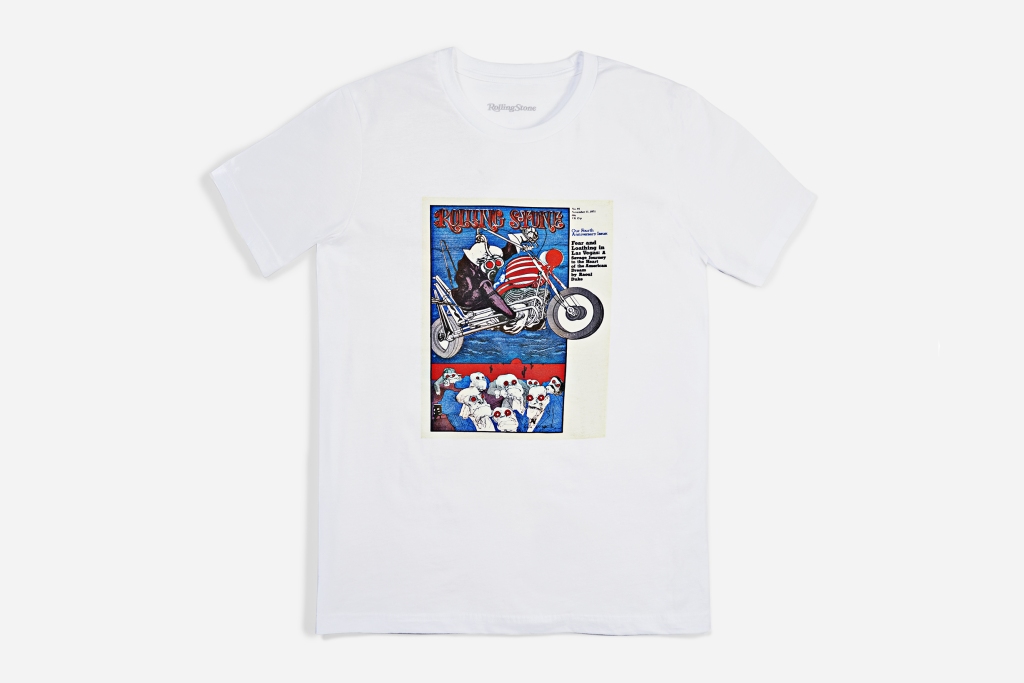Hunter Thompson has been the bane and the blessing of my life. He didn’t give a shit whether I slaved all night or worried all day. But he appreciated the drawings when they were there. He would certainly tell me if he thought a drawing sucked. Usually, that meant his prose sucked, and my drawing wasn’t doing: a bit more than it should. Hunter didn’t want a photographer. He wanted somebody who would become part of the story. Hunter loved having somebody like me along. He could play with me and take me to the edge and watch what I did, but pull me back before I fell over. We ended up doing six covers together, but we felt like a duo right away: Batman and Robin, or maybe Laurel and Hardy. Hunter thought my way of doing things was weirder than his. I’d sit there drawing people. He called it my “filthy habit.”
One night in Rhode Island, where we were covering the America’s Cup for Scanlan’s magazine. Hunter got two cans of spray paint, one red and one black, and my job was to write something artistic on the side of a yacht. So he rowed us out in a dinghy, but I was having hallucinogenic problems. I was seeing the water as red, and I just sprayed the paint in the air. When we got back, a rock & roll band had stolen my suitcase. All I had was the clothes I was wearing — and my passport and my ticket home in one pocket. Hunter had my shoes.
I went back to New York barefoot and gave a cabbie all the money I had, which was twenty-three dollars, to take me to an Irish pub in Times Square. There was a lovely Irish guy there I’d been talking to before the trip, He said, “You look fucking awful.” I ended up sleeping for twenty-four hours.
All my feelings came out six months later in London: I was purging my mind after a nasty experience and being sick on paper. It made me realize that something powerful could happen in a drawing — but you had to be in the right frame of mind for it.
I realized later that Rhode Island was a dress rehearsal for “Fear and Loathing in Las Vegas.” It would have been impossible for me to go on the “Fear and Loathing” trip. Hunter was traveling with Oscar Acosta, who was a lawyer — which was quite a good thought. They were supposed to illustrate the article with things they brought home, like coat-check tickets. Then Hunter remembered me and sent me the manuscript. I had never heard of Rolling Stone — it wasn’t widely available in England yet. But all the drawings spewed out. I sent in the package to Rolling Stone, and as Hunter told me in a letter, “They flipped, man.”
When I arrived at something I wanted to draw. I’d stop reading and draw it right then. It’s like arriving at a cafe or a truck stop: You don’t go any further. No pencils, otherwise you lose the virgin moment. I was using a pen, although sometimes I’d whack the art with a brush, when I wanted a big flash of ink, because it explodes on the paper. The drawings were what we call A-1 size over here — that’s American letter-size paper, times eight.
The idea of the cover was a motorbike flying over the journalists in a bar. There was also a landscape, a bit of sky. But the rider was completely attached to his motorbike, almost swallowed up by his gearbox. The second cover, for Part Two of “Fear and Loathing,” the magazine chose the picture of the 250-pound Texan necking with his wife in the back row. After those two issues, Rolling Stone had a blueprint of where to go next: It wasn’t only rock & roll, but something different, something social and political.
It was wonderful to do printing that was so primitive — and to finally have a job where the remit was to be weird.
Fear and Loathing in Las Vegas Cover Tee

Hunter S. Thompson wrote “Fear and Loathing in Las Vegas” in 1971, and it solidified his brand of Gonzo journalism that became his trademark. This iconic cover features an illustration by Ralph Steadman, which forever linked him with Thompson in the minds of readers. “He had a devil in him,” Steadman said of the journalist. “And it excited the devil in me.”
This article first appeared in the May 18-June 1, 2006 issue.

